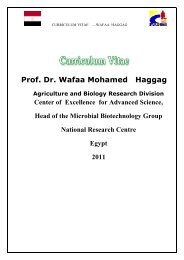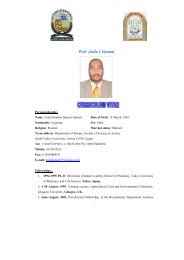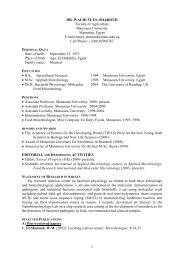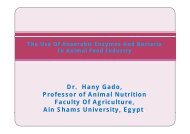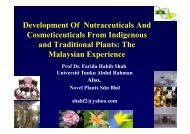Dr. Girish Sahni
Dr. Girish Sahni
Dr. Girish Sahni
Create successful ePaper yourself
Turn your PDF publications into a flip-book with our unique Google optimized e-Paper software.
<strong>Dr</strong>. <strong>Girish</strong> <strong>Sahni</strong><br />
INSTITUTE OF MICROBIAL TECHNOLOGY<br />
(CSIR) CHANDIGARH CHANDIGARH, INDIA
Design g of Target g Specific p Clot<br />
Busters<br />
by<br />
Protein Engineering Approaches
CSIR, IMTECH<br />
&<br />
the h microbial i bi lworld ld
Prevalence of Coronary Artery Disease<br />
Coronary artery disease has been the number<br />
one killer in the western world.<br />
As life-styles change, it has began to to affect<br />
millions across the worldwide.
* Th The discovery di of f clot l t dissolver di l drugs d has h led l d to t the th<br />
emergence of thrombolytic therapy.<br />
* Thrombolytic agents are mostly plasminogen<br />
activators.<br />
ti t
Schematic representation of the fibrinolytic system<br />
Plasminogen activators<br />
Plasminogen g activator<br />
Inhibitor<br />
Plasminogen g Plasmin<br />
Fibrin<br />
SK<br />
UK<br />
t-PA t PA<br />
APSAC<br />
α α22- Antiplasmin tpas<br />
Fibrin degradation<br />
product
SK SK:PG PG complex l<br />
Restored blood<br />
supply<br />
Fibrinogen<br />
Clotting factors<br />
Blood factors<br />
PG
All of the clot-buster clot buster drugs used in India<br />
and in most of the developing world<br />
were iimported t d till a few f years ago….<br />
Average cost of treatment for MI<br />
* Streptokinase : US $ 100 per dose<br />
• tPA : US $ 1200 per dose
Highlight<br />
Process developed developed at 300 litre fermentation fermentation scale<br />
scale<br />
• Negotiated & transferred in 2001<br />
• Commercialized by licensee in 2001<br />
• Recombinant form transferred in 2003<br />
clinical trials near completion, currently<br />
approaching commercialization<br />
• EEngineered i d( (clot-specific) l t ifi ) form f<br />
developed. Awaiting commercialization<br />
Average cost: US $ 20 !<br />
IMTECH
The challenge of constructing novel clotdissolver<br />
proteins with enhanced fibrin clot<br />
specificity p y
Acute need for second-generation Streptokinase<br />
derivatives with<br />
* increased plasma half-life<br />
* decreased immunogenicity<br />
* increased clot specificity
Molecular properties desired in a clot-specific<br />
Plasminogen g activator drug g<br />
Tight fibrin binding<br />
Localized plasminogen activation<br />
* Fibrin dependent activation<br />
* Time-delayed action<br />
* Plasmin dependent “molecular switch”
Structure-function studies on mechanism of<br />
hhuman plasminogen l i activation i i leading l di to the h<br />
design of clot-specific SK.<br />
Our fundamental studies over the last decade has<br />
revealed a unique mechanism for SK action at the<br />
molecular level that has enabled us to design<br />
improved versions of this life life-saver saver drug.
SK and PG form a very er tight binary binar complex comple<br />
SK PG
Our strategy to explore PG-binding<br />
domains in SK<br />
Streptokinase<br />
CnBr/Trypsin/Pepsin/V8 Protease<br />
“Large chunks”<br />
Probe b ffor PG-binding G bi di function/s<br />
f i /
Limited Proteolysis of Streptokinase with Trypsin<br />
1 59 143 293 414<br />
Nihalani et al., BBRC 1995; 217:1245<br />
Nihalani et al., Protein Sci. 1997; 6:1284<br />
Small peptides
Functional map of the plasminogen-interacting<br />
regions g in SK<br />
16 51 234 293 414<br />
SITE 1 SITE 2<br />
Region in SK that interacts with substrate PG<br />
Region in SK that interacts with partner PG to form a tight<br />
Region in SK that interacts with partner PG to form a tight<br />
binary complex
SK-α<br />
μPN<br />
SK-β<br />
SK- γ<br />
Crystal structure of SK in complex with the<br />
catalytic domain of HPN, solved at 2.9 Å<br />
Wang et al; Science (1998) 281: 1662
EK 281-282<br />
EK 272-273<br />
Ch dh t l 1999 P t i S i 8 2791<br />
Chaudhary et al., 1999., Protein Sci. 8: 2791;<br />
Yadav et al., 2008, BBA Proteins & Proteomics 1784: 1310<br />
Aneja et al., 2009., J Biol. Chem. 284:32642<br />
RE 248 248-249 249<br />
KK 256-257 256 257
Docking of kringle 5 of PG with the beta domain<br />
of SK<br />
Dhar et al., J. Biol. Chem. 2002; 277: 13257;<br />
Sundram et al 2003; J Biol Chem 2003; vol. 278: 30569
SK is a protein cofactor that modulates the<br />
substrate substrate preferance preferance of of plasmin plasmin by by providing providing Exosites Exosites<br />
SK<br />
PN Substrate PG<br />
Product PN<br />
Physiological functions
Some possible configurations for the design of FBD(4,5)-SK chimeric proteins.<br />
A. All the four FBD’s at the C-terminal of SK Fusion construct<br />
B. All the four FBD’s at the N-terminal of SK<br />
CFBD[1 C. FBD [1,2] 2]ffused dat the h CC-terminal i l of f SK<br />
D. FBD [1,2] fused at the N-terminal of SK<br />
E. FBD [4,5] fused at the C-terminal of SK<br />
F. FBD [4,5] fused at the N-terminal of SK<br />
GFBD[4 G. FBD [4,5] 5] fused f dat tb both thC C as well llas N-terminals Nt i l of f SK<br />
H. FBD [4,5] fused with in the body of SK<br />
SK-FBDs<br />
11,2,4&5 2 4&5<br />
FBD 1,2,4&5-<br />
SK<br />
SK-FBD 1,2<br />
FBD1,2- SK<br />
SK-FBD4,5<br />
FBD4,5-SK<br />
FBD4,5-SK-<br />
FBD4,5<br />
SK-FBD4,5<br />
SK-FBD4,5-<br />
SK.
Schematic representation of the engineered intergenic sequences<br />
of hybrid construct , FBD (4,5)- SK.<br />
TG site<br />
FBD<br />
4 5<br />
N<br />
C<br />
V- Q- A- Q- Q- I- V<br />
SK
SSchematic h ti representation t ti of f th the gene – bl blocks, k iincluding l di the th<br />
engineered intergenic sequences in the hybrid construct,<br />
FBD(4,5)– SK -FBD(4,5).<br />
TG site it FBD SK Gl Gly li linker k TG site it FBD<br />
4 5 4 5<br />
N C<br />
V-Q-A-Q-Q-I-V<br />
G-G-G<br />
QQ-A-Q-Q-I-V A Q Q I V
γ<br />
α<br />
γ<br />
β<br />
α<br />
β<br />
FBD<br />
FBD<br />
FBD<br />
FBD<br />
PN<br />
Design of a targeted “clot-buster” drug<br />
CLOTT<br />
PG No activation<br />
FBD<br />
FBD<br />
γ<br />
α<br />
β<br />
PN<br />
Degraded<br />
Clot
Plasmin-dependent activation of clot-specific<br />
streptokinase t t ki<br />
nSK<br />
Increasing PN<br />
PN depleted
Mechanism of delayed action<br />
Unlike native SK, protein engineered, clot-specific<br />
SK is activated in the presence of plasmin.<br />
Since the clot is plasmin-rich, and the blood plasma<br />
is plasmin-poor p p ( (due to its rapid p removal by yalpha-2 p<br />
Antiplasmin), the property of clot-specificity is<br />
iintroduced t d dautomatically. t ti ll
F<br />
E<br />
D<br />
C<br />
B<br />
A<br />
Schematic diagram of Circulatory plasma loop model system used<br />
for radioactive Fibrin clot lysis studies of SK, FBD(4,5)- FBD(4,5) SK and<br />
FBD(4,5)- SK- FBD(4,5).<br />
A. Magnetic stirrer, B. Magnetic bead, C. Reservoir containing plasma, E .Out let, F. Inlet into Reservoir, G<br />
.Peristaltic pump, H. Permeable Chamber containing Radiolabeled fibrin clot.<br />
H<br />
G
Clot dissolution with Native Streptokinase p<br />
Clot lyssis,<br />
%<br />
100<br />
80<br />
60<br />
40<br />
20<br />
0<br />
0 30 60 90 120 150 180 210 240 270 300<br />
Time, min
Clot-specific p Engineered g Streptokinase p<br />
Clot C lysis, %<br />
100<br />
80<br />
60<br />
40<br />
20<br />
0<br />
0 30 60 90 120 150 180 210 240 270 300<br />
Time, min
Non-specific fibrinogenolysis by different<br />
proteins<br />
Plasma fibrinogen<br />
conc. (relative)<br />
100<br />
80<br />
60<br />
40<br />
20<br />
0<br />
1 2<br />
3 4<br />
0 30 60 90 120 150 180 210 240 270 300<br />
5<br />
Time, min<br />
Curve 1 …. SK<br />
Curve 2 …. Constr. 1<br />
Curve 3 …. TPA<br />
Curve 4 …. Constr. 2<br />
Curve 5 …. Constr. 3<br />
Fibrinogenolysis in plasma milieu with different PG activators under conditions resulting in<br />
comparable lysis of clot but exhibiting varying circulating fibrinogen degradation due to “non-specific<br />
systemic” plasminogen activation. Note, however, the markedly high “fibrinogen protection” exhibited<br />
by the novel, clot-specific engineered SK (‘Construct 3’; curve 5).
Advantages of clot-specific clot specific streptokinase<br />
* Reduced systemic reactions (less side-effects)<br />
* Localized plasminogen activation<br />
* Decreased doses/economic benefits<br />
(greater efficacy at low doses)
CSSK Licensing to Nostrum Inc., USA in July 2006
The Group at IMTECH<br />
Abhay Pande K. Rajagopal<br />
Deepak Nihalani i i K L Dikshit i i<br />
Jagpreet Singh Vasudha Sundram<br />
Jayeeta Dhar Rajesh Kumar<br />
Amitabh Chaudhury Mahavir Yadav<br />
Paramjit j Kaur Nandita Garg g<br />
Anita Chaudhary<br />
S S Komath<br />
G P S Raghava
THANK YOU




